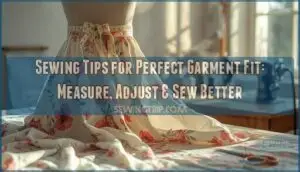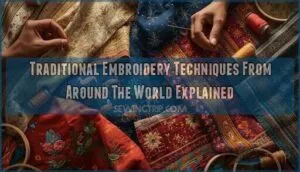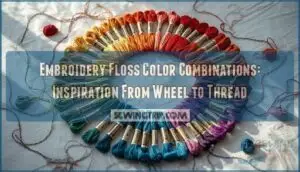This site is supported by our readers. We may earn a commission, at no cost to you, if you purchase through links.
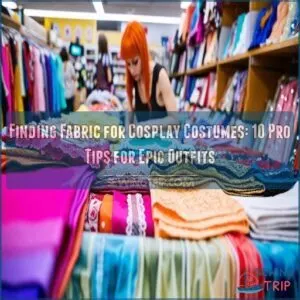 Finding fabric for cosplay costumes can be a thrilling quest.
Finding fabric for cosplay costumes can be a thrilling quest.
You’ll want to think about natural fibers like cotton for breathability, synthetics like spandex for flexibility, and specialty fabrics for that perfect character look.
Don’t forget to match the fabric to your character’s personality and era.
Comfort is key, so think about breathability and stretch.
On a budget? Get creative with thrift store finds or upcycled materials.
Test fabrics for durability and ease of sewing before committing.
Remember, the right fabric can make or break your cosplay.
But fabric selection is just the beginning – wait until you discover the magic of fabric manipulation techniques!
Table Of Contents
- Key Takeaways
- Essential Fabric Types for Cosplay Costumes
- Matching Fabrics to Character Designs
- Considering Comfort and Wearability in Fabric Selection
- Budgeting for Cosplay Fabrics
- Sourcing Fabrics for Cosplay Projects
- Evaluating Fabric Properties for Costume Construction
- Fabric Preparation Techniques for Cosplay
- Alternatives to Traditional Fabrics in Cosplay
- Fabric Manipulation Techniques for Costume Details
- Combining Fabrics for Complex Cosplay Designs
- Frequently Asked Questions (FAQs)
- Conclusion
Key Takeaways
- You’ll want to match your fabric to both character and comfort, considering the differences between lightweight, thin, and sheer fabric types, for example, to achieve a flowing and airy effect, while ensuring the material suits your character’s style and era.
- You can save money without sacrificing quality by exploring thrift stores, bulk purchasing, and upcycling materials – look for tablecloths, curtains, and bed sheets that can be transformed into costume pieces.
- You’ll need to prep your fabric properly before construction – pre-wash to prevent shrinkage, iron or steam block for a polished look, and consider treatments like waterproofing or flame retardants for durability.
- You don’t have to stick to traditional fabrics – explore alternatives like EVA foam for armor, thermoplastics for detailed pieces, and 3D printed materials for custom props to bring your costume vision to life.
Essential Fabric Types for Cosplay Costumes
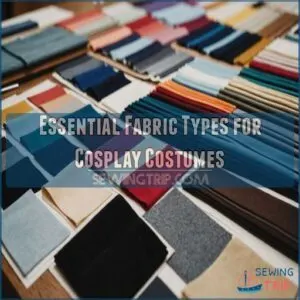
From natural fibers like cotton and silk to synthetics like polyester and spandex, considering the properties of types of sheer fabric can greatly impact your design choices. Each fabric has unique properties that can make or break your outfit.
Natural Fibers (Cotton, Linen, Wool, Silk)
If you’re looking for natural fibers for your cosplay creations, you’ve got a treasure trove of options.
Cotton, linen, wool, and silk each bring unique properties to the table.
Consider shopping for these fabrics from online stores that specialize in anime cosplay fabric.
Let’s break it down:
- Cotton: Versatile and breathable, perfect for light garments like shirts and skirts
- Linen: Lightweight with a rustic look, for medieval and fantasy costumes
- Wool: Warm and durable, great for colder climate characters
These fabrics offer comfort and authenticity, helping you nail that perfect costume look.
Synthetic Fibers (Polyester, Nylon, Spandex)
Synthetic fibers are your secret weapons for epic cosplay costumes.
Polyester, nylon, and spandex offer unique properties that’ll level up your outfits.
Let’s break down their superpowers:
| Fiber | Strength | Best For |
|---|---|---|
| Polyester | Quick-drying | Outdoor costumes |
| Nylon | Durability | Flexible pieces |
| Spandex | Stretchy | Skin-tight suits |
Polyester’s your go-to for moisture-wicking.
Nylon’s strength makes it perfect for high-wear areas.
Spandex adds that superhero-worthy stretch.
Mix and match these fibers to create costumes that’ll turn heads at any con.
Specialty Fabrics (Metallic, Embroidered, Renaissance)
Specialty fabrics add that magical touch to your cosplay.
You’ll shine like a star with metallic fabrics, perfect for Sailor Moon’s accessories.
For a Stranger Things 80s vibe, try embroidered patterns.
Renaissance-inspired costumes? Look for rich brocades and velvets.
These fabrics can be tricky to work with, so practice first.
Remember, a little goes a long way – use specialty fabrics as accents to make your costume pop without breaking the bank.
Performance Fabrics (Moisture-wicking, Breathable)
Performance fabrics are your secret weapon for cosplay comfort.
You’ll feel like a superhero with moisture-wicking tech that draws sweat away from your skin.
These fabrics keep you cool and dry, even during intense convention days.
Look for fabrics with an open weave and lightweight design, such as breathable fabrics list, that allow for maximum airflow and moisture-wicking properties.
Here’s why they’re a game-changer:
- Breathable design allows air circulation
- Prevents chafing and skin irritation
- Lightweight feel enhances freedom of movement
Say goodbye to sticky costumes and hello to all-day comfort!
Matching Fabrics to Character Designs
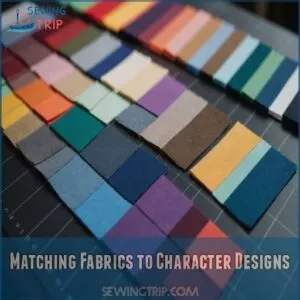
You’re the puppet master, pulling the strings to bring your cosplay to life.
Think about your character’s personality and era. Are they a medieval knight or a futuristic space cadet? This’ll guide your fabric choices.
For a character that requires comfort and ease of movement, consider incorporating moderate stretch fabric options.
Check out this handy table for quick inspiration:
| Character Type | Fabric Suggestions |
|---|---|
| Fantasy Warrior | Faux leather, metallic |
| Sci-Fi Hero | Sleek spandex, holographic |
| Vintage Vixen | Cotton prints, satin |
| Anime Protagonist | Bright polyester, tulle |
| Steampunk Inventor | Tweed, brocade |
Remember, it’s all about the details. Match textures and prints to your character’s vibe.
For example, asymmetrical designs can reflect a chaotic personality. Don’t be afraid to get creative – even designing your own fabric can nail that perfect look.
Considering Comfort and Wearability in Fabric Selection

Choose fabrics that breathe, stretch, and feel good against your skin to avoid the dreaded "cosplay sweat" and keep you feeling fresh from photo ops to panels.
Breathability and Temperature Regulation
Two key factors in cosplay comfort are breathability and temperature regulation.
Choose fabrics that let your skin breathe, especially for summer events or indoor conventions.
Opt for natural fibers like cotton or moisture-wicking synthetics.
Layer your costume for versatility in changing weather.
Consider built-in ventilation or removable pieces.
Remember, a cool cosplayer is a happy cosplayer. Don’t let your epic outfit turn into a sweat fest!
Stretch and Flexibility
Comfortable cosplay is all about movement.
While breathable fabrics like rayon, which mimics natural fabrics, keep you cool, stretchy materials let you strike those epic poses without feeling like you’re wrapped in cardboard.
Think of spandex as your secret weapon for flexibility (Source).
Here’s why stretchy fabrics rock:
- They hug your body like a second skin
- You can bend, twist, and flex without restrictions
- They’re perfect for form-fitting superhero suits
- They bounce back to shape after each wear
Choose wisely, and you’ll feel like a superhero all day long.
Weight and Drape
Fabric weight and drape can make or break your cosplay.
Heavier fabrics often have less drape, while lighter ones flow more freely.
But don’t judge a book by its cover – some heavy fabrics, like wool crepe, can still flow beautifully.
Consider your character’s style and movement.
A flowing cape needs different fabric than a structured uniform.
Test fabrics by draping them over your arm to see how they’ll move with you.
Skin Sensitivity and Allergies
Your skin’s comfort is the secret sauce to cosplay success.
Don’t let itchy fabrics rain on your parade.
Try fabric allergy testing before committing to a costume.
Opt for cosplay safe fabrics like breathable cotton or silk.
If synthetic materials make you break out in hives, explore natural fiber options.
Remember, irritant-free fabrics are your best friends.
Can’t find the perfect match?
Think outside the box with alternative materials.
Your skin will thank you!
Budgeting for Cosplay Fabrics
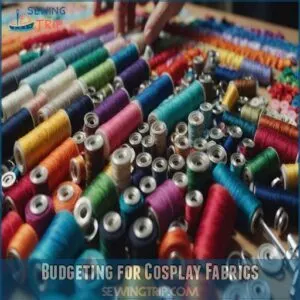
Cost-effective Fabric Options
Creating epic cosplay outfits doesn’t have to break the bank.
Smart fabric sourcing can save you a bundle.
Here are three budget-friendly alternatives:
- Thrift store tablecloths: Snag vinyl tablecloths for a leather-like look at a fraction of the cost.
- Upcycled shelf liner: Transform this simple material into lightweight chainmaille.
- Bulk buying: Purchase larger quantities of fabric to score discounts.
With these clever tricks, you’ll master the art of budget cosplay without sacrificing style.
Balancing Quality and Price
Let’s talk shop about getting the most bang for your buck.
Regarding cosplay fabrics, you don’t always have to break the bank for quality.
Think of it like a seesaw – you’re aiming for that sweet spot between cost and durability.
Compare budget-friendly alternatives with higher-end options.
Sometimes, a clever DIY trick can give cheaper materials a premium look.
Remember, it’s all about smart trade-offs to bring your character to life.
Bulk Purchasing and Discounts
Stretch your cosplay budget by exploring bulk purchasing options.
Many fabric vendors offer bulk deals that can greatly reduce your costs.
Before placing a large order, consider these tips:
- Compare prices across multiple suppliers
- Factor in shipping costs for heavy orders
- Check order minimums to avoid overbuying
Smart shopping can turn you into a fabric-hoarding dragon, ready to tackle any cosplay challenge.
Remember, bulk buying isn’t just about saving money – it’s about building your costume empire.
Upcycling and Repurposing Materials
You’ve mastered bulk buying, now it’s time to become a fabric upcycling ninja.
Raid your closet for old clothes or hit the thrift stores for hidden gems.
Transform outdated jackets into epic armor or turn grandma’s curtains into a majestic cape.
You can repurpose old clothes and household items into new projects, like upcycling old fabrics, to craft unique costume pieces while saving money and the planet.
It’s like turning trash into cosplay treasure!
Sourcing Fabrics for Cosplay Projects
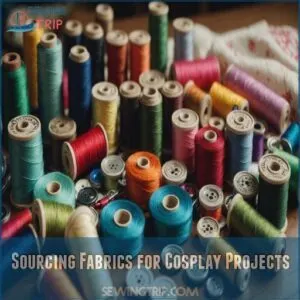
You’ll discover a world of options from online retailers and local fabric stores to thrift shops and specialty cosplay supply outlets.
Online Fabric Retailers
Online fabric retailers open up a world of possibilities for cosplayers.
Compare shipping costs and return policies to avoid surprises.
Check out customer reviews to gauge fabric quality and service.
Don’t shy away from asking for swatches – they’re your best bet for matching colors accurately.
Remember, what you see on screen mightn’t always match reality, so double-check fabric properties before hitting that buy button.
Local Fabric Stores
Local fabric stores offer a hands-on experience you can’t get online.
Touch the fabrics, see true colors, and get expert advice from fabric store staff.
They’re goldmines for hidden fabric gems and local fabric trends.
Here are four fabric shopping tips for your next visit:
- Bring swatches to match colors accurately
- Make a project list to stay focused
- Wear comfy shoes for extended browsing
- Check for fabric store events to snag deals
Thrift Stores and Second-hand Options
Savvy cosplayers know thrift stores are gold mines for budget-friendly fabrics.
Don’t just eye garments; focus on fabric types, colors, and patterns.
Bed sheets and curtains make great base materials if you’re handy with a sewing machine.
Repurpose skirts into tops or vice versa with clever cutting.
Keep an open mind and you’ll uncover unique materials for sustainable cosplay.
Remember, thrifting’s about creative problem-solving and giving new life to discarded goods.
Specialty Cosplay Supply Shops
Cosplay fabric meccas are your secret weapon for epic outfits.
These specialty shops cater to your wildest costume dreams, offering:
- Hard-to-find materials like Worbla and CosBond
- Expert advice from fellow cosplay enthusiasts
- One-stop shopping for fabrics, wigs, and accessories
You’ll find unique offerings and high-quality fabric both online and in-store.
While local shops let you touch and feel materials, online stores often have a wider selection.
Choose based on your project needs and cosplay vision.
Evaluating Fabric Properties for Costume Construction
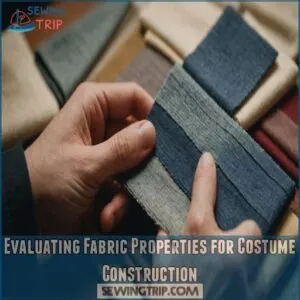
Check for durability, sewing ease, color retention, and special effects like shimmer or texture to create the perfect outfit for your character.
Durability and Wear Resistance
Now that you’ve found your fabric sources, let’s talk durability. You want your costume to survive more than one con, right?
Test fabrics for wear resistance by rubbing them together.
Check stress points like elbows and knees.
Oxford fabric is a champ for durability.
For high-performance needs, consider aramid or carbon fibers.
Remember, a little extra investment in tough materials can save you from costume disasters down the road.
Ease of Sewing and Manipulation
Your costume’s durability is key, but let’s talk about how easily you can work with your fabric.
Consider the total ease indicated on the pattern to make sure your costume has enough room for movement and comfort, understanding ease in sewing.
Choose materials that play nice with your sewing tools.
Stretchy fabrics can be tricky, so don’t over-stretch them while sewing.
A walking foot can be especially helpful when sewing jerseys or knit fabrics, which are made by interlocking loops of yarn. A walking foot can be your best friend for jersey fabrics.
When choosing a fabric, consider the essential techniques you’ll need to master, such as cutting and staystitching, which can be found in a comprehensive guide on how to cut & sew. Remember, different fabrics require different stitch types and pattern drafting techniques.
Lightweight fabrics are often easier to manipulate, but they mightn’t hold their shape as well.
Color Fastness and Fading
After mastering fabric manipulation, let’s talk about keeping those colors vibrant.
Think you’ve found the perfect shade? Hold your horses! Color bleeding can turn your costume from fab to drab faster than you can say "wardrobe malfunction."
Here’s how to keep your colors true:
- Test for dye stability
- Pre-wash fabrics with salt
- Use color catchers in the wash
- Apply color fixatives for stubborn dyes
Don’t let your hard work fade away – a little prep goes a long way.
Special Effects (Shimmer, Texture, Patterns)
Colors aren’t the only way to make your cosplay pop.
Shimmering fabrics can add that extra sparkle to your character.
Try glitter prints or reflex prints for eye-catching 3D effects.
For a chameleon-like twist, explore two-colored pigments that change hues based on light and viewing angle.
Don’t forget texture techniques like embroidery or appliqué to bring depth to your costume.
Mix and match fabric combinations for truly unique special effects.
Fabric Preparation Techniques for Cosplay
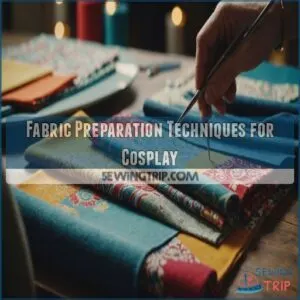
Proper preparation techniques like pre-washing, ironing, and treating your fabric will make sure your costume looks polished and holds up to convention wear.
Pre-washing and Shrinkage Prevention
Try pre-washing to dodge costume disasters.
Different fabric types shrink at varying rates, so test a swatch first.
Here’s your pre-wash game plan:
- Use cold water for delicates and hot for sturdy fabrics
- Toss in similar colors to prevent bleeding
- Air-dry or tumble on low heat to minimize shrinkage
Don’t skip this step – you’ll thank yourself later when your cosplay fits like a glove.
Ironing and Steam Blocking
Now that your fabric’s clean, let’s smooth things out.
Ironing and steam blocking are your secret weapons for a polished look.
Set your iron to the right heat for your fabric type.
Steam helps relax stubborn wrinkles and set the fabric grain.
For delicate materials, use a pressing cloth.
Remember, a crisp costume is the foundation of a show-stopping cosplay.
You’ve got this, iron warrior!
Fabric Treatments (Waterproofing, Flame Retardants)
When it comes to fabric safety, you’ll want to consider treatments that elevate your cosplay game.
Waterproofing keeps you dry during outdoor events, while flame retardants are essential for meeting cosplay regulations.
DIY treatments can be budget-friendly, but weigh the long-term effects.
Eco-friendly options are available for the environmentally conscious cosplayer.
Remember, these treatments can affect your fabric’s texture and behavior, so always test on scraps first.
Pattern Layout and Cutting Strategies
Your fabric’s prepped and ready.
To avoid errors during the cutting process, remember to mark notches instead of simply clipping a slit into the seam allowance, as shown in the guide on cutting pattern pieces.
Let’s tackle pattern layout and cutting.
Always check the grain line – it’s your compass for perfect fitting costumes.
Scale patterns to fit your measurements, then arrange pieces like a puzzle to minimize waste.
Use layout tools like pattern weights to keep everything in place.
Remember, a well-planned layout is half the battle won in cosplay creation.
Alternatives to Traditional Fabrics in Cosplay
You don’t need to stick to traditional fabrics for your cosplay creations. Explore alternatives like foam, thermoplastics, faux leather, and 3D printed materials to bring your costume ideas to life.
Foam and Thermoplastics
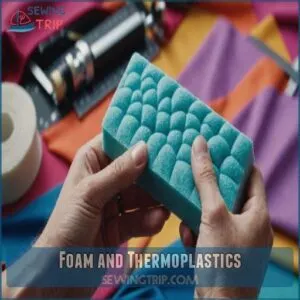
These materials let you craft stunning pieces without metalworking skills.
Choose foam for cost-effective, lightweight armor or thermoplastics for durability and a metal-like finish.
Consider foam thickness for structural integrity and thermoplastics shaping techniques for intricate details.
Remember safety when working with heat guns and always prioritize proper ventilation.
Leather and Faux Leather
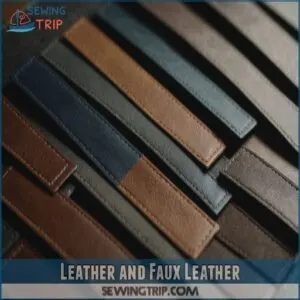
They’re durable, shape-holding, and perfect for rustic or fantasy characters.
But watch out – real leather can be tough on your sewing machine.
Faux leather‘s your wallet-friendly sidekick here.
For a budget-friendly option, check out Yaya Han’s 4-way stretch line.
Remember, these materials don’t forgive pin holes, so use tape to hold patterns.
You’ll be rocking that leather look in no time!
3D Printed Materials
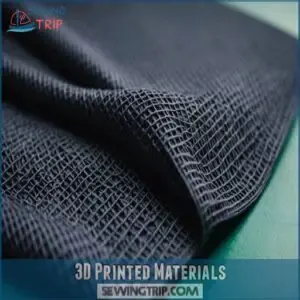
While faux leather works for armor, PLA and TPU materials offer exciting new options for props and accessories.
Here’s what makes 3D printing perfect for cosplay:
- Print flexible TPU for bendy costume pieces that won’t crack
- Create ultra-precise armor details with PLA filament
- Design custom-fit props with exact measurements
- Save money by printing multiple small pieces at once
Unconventional Materials (Paper, Plastic, Metal)
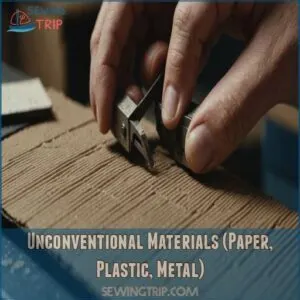
You can create lightweight armor from paper mache that’s surprisingly durable and convention-ready.
Let’s explore your creative options:
| Material | Best Uses | Pro Tips |
|---|---|---|
| Paper Mache | Props, Masks | Use non-coated newsprint for strength |
| Plastic | Armor Pieces | Heat-form EVA foam for flexibility |
| Metal Accents | Decorative Details | Test durability before conventions |
| Cardboard | Base Structures | Reinforce with aluminum foil |
| Upcycled Items | Custom Props | Seal with Mod Podge for longevity |
Fabric Manipulation Techniques for Costume Details
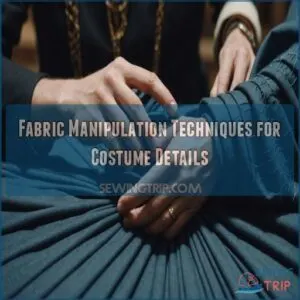
These fabric manipulation methods will help you create authentic details.
From elegant Renaissance gowns to battle-worn armor pieces.
Pleating and Gathering
Through mastery of pleating techniques and gathering methods, you’ll learn the secret to creating stunning costume details that’ll make your cosplay stand out.
Start with simple gathers using your machine’s longest stitch setting – just pull one thread to create fullness.
For pleats, test different styles by hand to discover what works best.
You’ll need basic tools: straight pins, an iron, and measuring tape for precise folds.
Appliqué and Embroidery
Detailed embroidery can transform your basic fabric into a masterpiece worthy of any convention floor.
You’ll want to start with simple appliqué designs using iron-on backing for stability.
Try chain stitches for borders and satin stitches for filling larger areas.
Don’t shy away from metallic threads – they’ll catch the light perfectly in photos.
For intricate patterns, consider using embroidery stabilizer to prevent puckering.
Dyeing and Painting Fabrics
To change fabric colors, you’ll need to master some essential dyeing and painting techniques.
Working in a well-ventilated area, let’s explore your fabric’s potential with these key steps:
- Always wear protective gear – gloves and masks are non-negotiable for dye safety
- Mix dyes in metal containers you’ll use exclusively for dyeing
- Test your techniques on fabric swatches first
- Keep your workspace covered with protective materials
- Use warm water to help dissolve dye crystals completely
Distressing and Weathering Effects
Ready to master the art of battle-worn costumes? You’ll transform pristine fabric into convincingly aged masterpieces with these tested distressing techniques.
Mix instant coffee with cinnamon for rusty effects, or use tea solutions for authentic sweat stains.
Create strategic wear patterns at elbows and knees for realism.
| Technique | Effect | Pro Tip |
|---|---|---|
| Tea spray | Yellow sweat stains | Use unsweetened to prevent nozzle clogs |
| Coffee/curry blend | Sandy texture | Perfect for desert warriors |
| Sandpaper rubs | Natural wear spots | Focus on high-friction areas |
Combining Fabrics for Complex Cosplay Designs
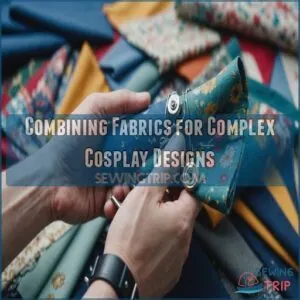
Layering Different Fabrics
Now you’re ready to level up your cosplay game with fabric layering.
This technique adds depth and dimension to your costume, making it pop.
You’ll become a fabric-stacking pro in no time!
Here’s how to nail it:
- Start with a lightweight base layer for comfort
- Add a medium-weight fabric for structure
- Top it off with a flashy outer layer for visual impact
- Use interfacing between layers for a polished look
Mixing Textures and Finishes
Take your cosplay to the next level by mixing textures and finishes.
Combine smooth spandex with rough leather or pair shiny metallic fabric with matte cotton.
Consider incorporating suede vs velvet difference to add a luxurious feel to your costume.
These fabric combos create visual interest and depth.
Try layering a pearlescent finish over a base color for a unique effect.
Experiment with contrast: pair a glossy bodice with a textured cape.
You’ll master the art of texture blending, giving your costume a professional edge.
Incorporating Non-fabric Elements
You’ve got the fabric nailed down, but let’s kick it up a notch with some non-fabric elements.
These additions can transform your cosplay from good to jaw-dropping.
Here’s how to level up:
- Foam armor: Craft lightweight, detailed pieces that look like metal
- 3D printing: Create intricate props or armor pieces with pinpoint accuracy
- Upcycled materials: Turn everyday items into unique costume elements
Remember, blending fabrics with these elements is like cooking – it’s all about balance and experimentation.
Balancing Weight and Structure
Balancing fabric weight and structure is key for complex cosplay designs.
Mix heavy fabrics for structural support with lighter ones for comfort.
Distribute weight evenly to avoid back strain.
Layer fabrics strategically to achieve the right shape and volume.
For stability, consider silk-wool blends or duchess satin.
Remember, your costume should look epic and feel great – it’s all about finding that sweet spot between form and function.
Frequently Asked Questions (FAQs)
Can you make cosplay with fabric?
You can craft amazing cosplay with fabric.
Choose materials wisely – stretchy for catsuits, stiff for corsets.
Test samples first.
With the right fabric and techniques, you’ll bring characters to life.
It’s a fun, creative challenge!
What is cosplay fabric used for?
Picture a blank canvas waiting to be transformed.
Cosplay fabric is your paintbrush, bringing characters to life.
You’ll use it to craft bodysuits, princess gowns, and everything in between.
It’s the key to realizing your cosplay dreams (Source).
What materials do cosplayers use to make costumes?
You’ll need a variety of materials for cosplay costumes.
Fabrics like spandex and leather form the base.
EVA foam and Worbla shape armor and props.
Don’t forget resin for detailed pieces and a trusty dremel for crafting.
How do you make a cosplay costume look cool?
Imagine a Batman cosplay that wows crowds.
Iron your costume to banish wrinkles.
Add realistic weathering with sandpaper and paint.
Fit armor snugly to your body.
Use black makeup around eyes for that brooding hero look.
How to know what fabric to use for cosplay?
Consider your character’s design and needed fabric qualities.
Touch samples, matching colors and textures to references.
Natural fibers like cotton breathe well for all-day wear.
Synthetic stretch fabrics work for form-fitting looks.
Don’t shy away from asking store employees for advice.
What is the best cheap fabric for cosplay?
Cotton poplin‘s your budget-friendly cosplay hero.
It’s versatile, easy to sew, and perfect for light garments.
For a royal touch without breaking the bank, crushed velvet adds texture and drama.
Thrift stores offer hidden fabric gems too.
What do cosplayers make their costumes out of?
Cosplayers craft their costumes from a variety of fabrics.
You’ll find poplin for light garments, spandex for bodysuits, and organza for magical effects.
Don’t forget synthetic blends for durability.
Mix and match to bring your character to life!
What material is used for cosplay?
Explore a world of imagination with cosplay materials.
You’ll transform with fabrics like cotton and spandex, sturdy EVA foam for armor, and versatile thermoplastics like Worbla.
Craft foam’s your budget-friendly ally.
Mix and match to bring your character to life.
How to handle delicate or sheer fabrics in cosplay?
Handle delicate fabrics like a pro!
Cut single layers for precision.
Use pattern weights and a rotary cutter .
Finish edges with bias tape.
Remember, practice makes perfect.
You’ll be crafting dreamy costumes in no time, feeling like a fabric wizard!
Best practices for dyeing fabric for costume accuracy?
Did you know 90% of cosplayers dye their own fabric?
You’ll nail costume accuracy by using natural fibers like cotton, which dye beautifully.
Test on scraps first, control color intensity with stovetop dyeing, and don’t skimp on salt for vibrant results.
Fabric choices for armor-like components in cosplay?
You’ll create stunning armor pieces using cotton-polyester blends for flexibility and durability (Source). E-6000 adhesive bonds perfectly with most materials, while spray adhesives like 3M Super 77 work great for layering components.
Tips for working with stretch fabrics in tight-fitting costumes?
Select four-way stretch materials for the best fit and mobility.
Pin generously to control slippery fabrics, and work with a low-heat iron through a press cloth.
Consider using fabric tape while sewing zippers.
How to create texture effects on fabric surfaces?
Transform fabric into a million possibilities!
Create realistic wear with actual dirt for authentic stains.
Add weathered effects using sandpaper or flame.
Master splatter techniques with spray paint or acrylic for that perfect lived-in look.
Conclusion
Creating your perfect cosplay starts with finding fabric for cosplay costumes that match your vision.
You’ve now got the knowledge to choose materials that’ll make your character come alive – from natural fibers to specialty fabrics.
Don’t forget to test your choices for comfort and durability.
Whether you’re crafting your first costume or your fiftieth, these fabric selection tips will help you transform from enthusiast to master costumer.
Now get out there and bring your favorite characters to life!

